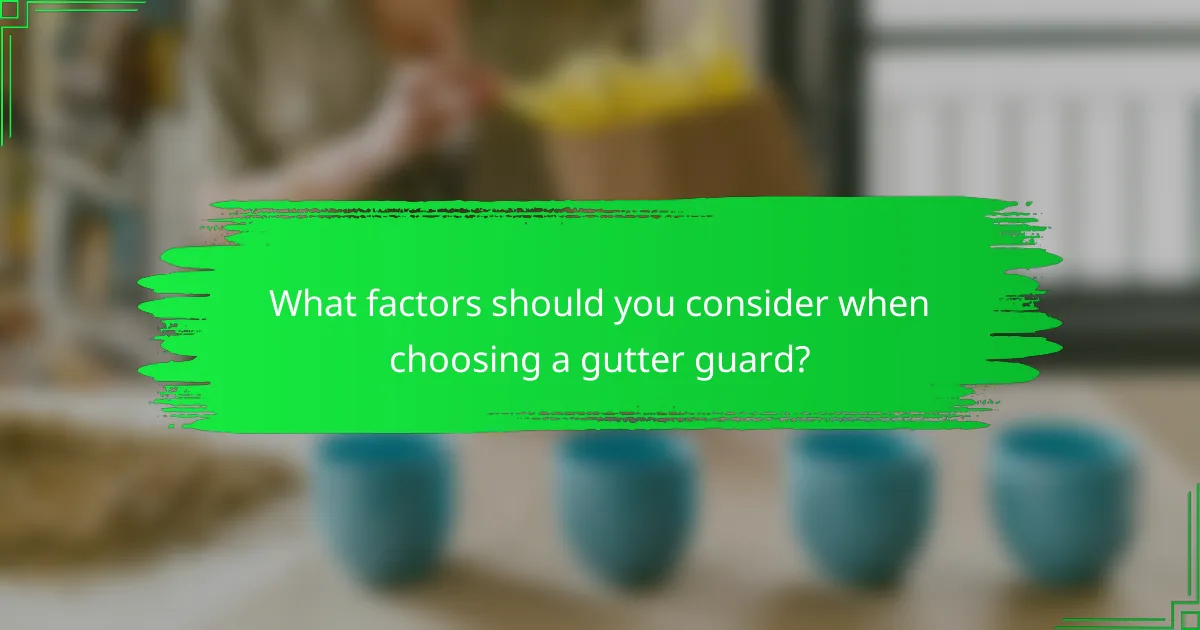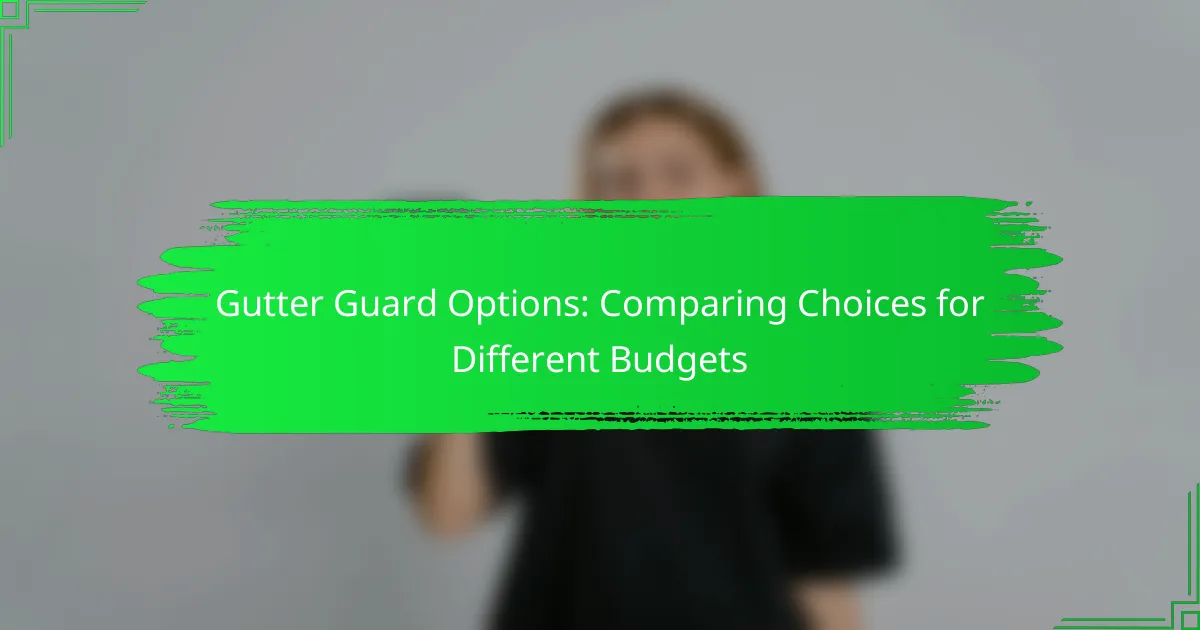When it comes to protecting your gutters, budget-conscious homeowners have a variety of effective gutter guard options to consider. From mesh and screen guards to foam inserts and micro-mesh solutions, each type offers unique benefits tailored to different price points. Understanding the advantages and disadvantages of each option can help you make an informed decision that aligns with your financial considerations and maintenance needs.

What are the best gutter guard options for budget-conscious homeowners?
Budget-conscious homeowners can choose from several effective gutter guard options that balance cost and performance. The best choices typically include mesh, reverse curve, screen, foam inserts, and micro-mesh guards, each offering unique benefits and price points.
Mesh gutter guards
Mesh gutter guards are made from a fine mesh material that allows water to flow through while blocking leaves and debris. They are generally affordable and easy to install, making them a popular choice for homeowners looking to save money.
When selecting mesh guards, consider the size of the mesh openings. Smaller openings prevent more debris from entering the gutters but may require more frequent cleaning if they become clogged. Prices typically range from $1 to $3 per linear foot.
Reverse curve gutter guards
Reverse curve gutter guards use a design that directs rainwater into the gutter while allowing leaves and debris to slide off. These guards can be more expensive, often costing between $3 and $10 per linear foot, but they are effective at minimizing maintenance.
Installation can be more complex, so hiring a professional may be necessary, which adds to the overall cost. However, their durability and effectiveness can make them a worthwhile investment for long-term savings.
Screen gutter guards
Screen gutter guards consist of a simple screen material that fits over the gutter, preventing large debris from entering. They are typically less expensive than reverse curve options, with prices ranging from $1 to $5 per linear foot.
While they are easy to install, screens may require regular cleaning, especially in areas with heavy foliage. Homeowners should ensure the screen material is sturdy enough to withstand weather conditions.
Foam gutter inserts
Foam gutter inserts are made from porous foam that sits inside the gutter, allowing water to flow through while blocking debris. These inserts are often the most affordable option, costing around $0.50 to $2 per linear foot.
However, they can retain moisture and may need to be replaced more frequently than other types. Homeowners should check them regularly to ensure they are not becoming saturated or clogged.
Micro-mesh gutter guards
Micro-mesh gutter guards feature a very fine mesh that blocks even small debris while allowing water to flow freely. They are more expensive, typically ranging from $3 to $7 per linear foot, but offer superior performance and require less maintenance.
These guards are often made from durable materials that can withstand harsh weather, making them a solid long-term investment. Installation may require professional help, but the reduced cleaning frequency can save time and effort in the long run.

How do gutter guard prices vary by type?
Gutter guard prices can differ significantly based on the type of guard chosen, with costs typically ranging from low to high. Factors influencing these prices include material quality, installation complexity, and long-term durability.
Cost of mesh gutter guards
Mesh gutter guards are generally affordable, with prices ranging from around $1 to $4 per linear foot. They are made from various materials, including plastic and metal, which can affect durability and performance.
When selecting mesh guards, consider the size of the mesh openings. Smaller openings can prevent debris from clogging gutters but may require more frequent cleaning. Installation can be a DIY project or professional, impacting overall costs.
Cost of reverse curve gutter guards
Reverse curve gutter guards typically cost between $3 and $10 per linear foot. These guards are designed to direct water into the gutter while allowing debris to fall off the edge.
While they can be effective in preventing clogs, installation can be complex, often requiring professional help. This added labor cost should be factored into your budget when considering this option.
Cost of screen gutter guards
Screen gutter guards usually range from $2 to $5 per linear foot. They feature a simple design that allows water to flow through while blocking larger debris.
Screen guards are easy to install and can be a good choice for DIY enthusiasts. However, they may not be as effective against smaller debris, which could lead to occasional maintenance needs.
Cost of foam gutter inserts
Foam gutter inserts are among the more affordable options, costing between $1 and $3 per linear foot. Made from porous foam, they fit directly into the gutter and allow water to flow while blocking debris.
These inserts are easy to install and remove for cleaning. However, they may need replacement every few years, which can add to long-term costs.
Cost of micro-mesh gutter guards
Micro-mesh gutter guards are typically priced higher, ranging from $5 to $12 per linear foot. They feature a fine mesh that effectively blocks even small debris while allowing water to flow freely.
These guards are durable and often come with warranties, making them a solid long-term investment. However, their higher initial cost and potential installation fees should be considered when budgeting.

What are the pros and cons of each gutter guard type?
Each type of gutter guard offers distinct advantages and disadvantages that can impact their effectiveness and suitability for different budgets. Understanding these pros and cons helps homeowners make informed decisions based on their specific needs and financial considerations.
Advantages of mesh gutter guards
Mesh gutter guards are effective at keeping debris out while allowing water to flow freely. They are typically made from durable materials like stainless steel or plastic, which can withstand various weather conditions. Their affordability makes them a popular choice for budget-conscious homeowners.
Additionally, mesh guards are relatively easy to install, often requiring minimal tools and expertise. This DIY-friendly aspect can save on installation costs, making them an attractive option for those looking to manage expenses.
Disadvantages of mesh gutter guards
While mesh gutter guards are beneficial, they can still allow smaller debris, such as seeds and pine needles, to enter the gutters. This can lead to clogs over time, necessitating regular maintenance and cleaning. Homeowners should be prepared for occasional upkeep to ensure optimal performance.
Moreover, some lower-quality mesh guards may rust or degrade over time, particularly in harsh climates. Investing in higher-quality materials is essential to avoid replacement costs sooner than expected.
Advantages of reverse curve gutter guards
Reverse curve gutter guards are designed to direct water into the gutter while allowing debris to slide off the edge. This design minimizes the need for frequent cleaning, making them a low-maintenance option for homeowners. They are particularly effective in areas with heavy rainfall.
These guards are often made from durable materials that can withstand various weather conditions, providing long-term protection for gutters. Their effectiveness in preventing clogs can lead to fewer repairs and maintenance costs over time.
Disadvantages of reverse curve gutter guards
One significant drawback of reverse curve gutter guards is their higher initial cost compared to other types, which may not fit every budget. Installation can also be more complex, often requiring professional help, adding to the overall expense.
Additionally, if not installed correctly, these guards can lead to water overflow, which may cause damage to the home’s foundation. Homeowners should ensure proper installation to avoid potential issues and ensure the guards function as intended.

What factors should you consider when choosing a gutter guard?
When selecting a gutter guard, consider factors such as material durability, installation type, maintenance requirements, and budget. Each of these elements influences the effectiveness and longevity of the gutter guard system.
Material durability
Material durability is crucial when choosing a gutter guard, as it determines how well the guard will withstand environmental conditions. Common materials include aluminum, stainless steel, plastic, and mesh, each offering varying levels of strength and resistance to rust or corrosion.
Aluminum guards are lightweight and resistant to rust, making them a popular choice for many homeowners. Stainless steel offers superior durability and longevity but can be more expensive. Plastic options are often less durable and may not perform well in extreme weather conditions.
When selecting a material, consider your local climate. For instance, areas with heavy snowfall may benefit from more robust materials like stainless steel, while regions with milder weather might find aluminum sufficient. Always check for warranties that reflect the expected lifespan of the material used.
